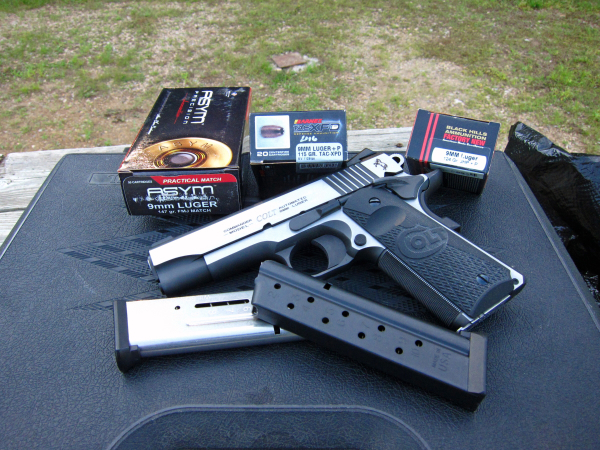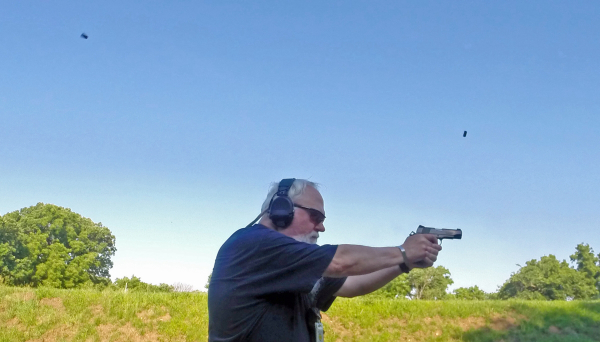
Combat Elite Commander 9mm. The only problems in the evaluation with the pistol were some failures to go into battery. At the time, it occurred to me that it could be shooter-induced or it could have to do with the ammo. I decided that I’d check a small variety of 9mm loads, varying in bullet weight, for accuracy to see if there was a preference. I also had a plastic bag with assorted lose rounds of 9mm. There was all-copper hollow point +P, some flat-nose hardball and various other loads.
There having been only one magazine supplied with the pistol, I got into my gear pile and found previously used 9mm 1911 magazines from a pair of makers. These were Brownells 10-round and Wilson Combat 10-round magazines. The Brownells magazines are made of stainless steel and have a dark coating, Xylan fluoropolymer coating, if it matters, both corrosion resistant and slick. The Wilson Combat ETM (Elite Tactical) units are likewise 10-round stainless mags, each with a nose-dive preventing ramp on the magazine tube.
I set a target at twenty five yards and took a seated rest, shooting over a plastic pistol case. I found that groups including my shooter-induced and called fliers tended around four inches. There were some shining moments, like with the lamented ASYM Practical Match 147 grain FMJ, which clustered into 1 ½” and the Barnes 115 grain Tac-XPD +P that printed a 2 ½” group. The normally-accurate 124gr. JHP +P from Black Hills didn’t set well with the Colt; it’s been my ‘go-to’ for a +P load that’s accurate for years.
That’s the difference in guns; some have preferences for ammo. This may well be one – or perhaps my shooting was off.

Taking the vastly varied ‘bag ‘o bullets’ and randomly loading magazines, I set to doing some handling drills. I’d been using the 1911 type of pistol too seldom since the 1990s and my shooting showed it. The Colt Combat Elite Commander chugged through all the various types of ammunition with no stoppages. There seemed to be little difference in point of aim v. point of impact across the selection of bullet weights and form factors. The pistol seemed very willing to do good work as long as I paid attention to grip and trigger.
This gun is very nicely fitted and finished. The sights are very good, the finish and checkering are on par with some very pricey custom pistols. The stocks are just fine, except I’d likely try to get into a set of the white ‘ivory-looking’ scales from VZ Grips if this gun were mine – just for looks.
As to the 9mm in a 1911, if you believe it’s sacrilegious, you’re entitled. When Colt was trying to ensure they stayed in the Army pistol business after WWII, they made a lighter, shorter 1911-type pistol for a potential service pistol replacement to the U.S. pistol, caliber 45, Model 1911-A1 – the Commander, an aluminum frame 1911 with a 4 ¼” barrel in 9mm Luger.

So back around we’ve come to 1949, this time in stainless steel, with improved magazines, a drop-safe firing pin block, night sights, G10 stocks and nice checkering and finish treatment.
Seems like a good deal to me.
-- Rich Grassi